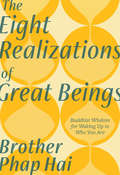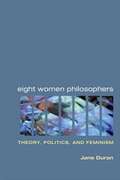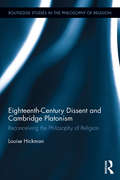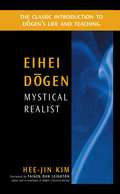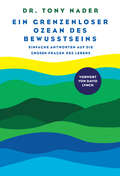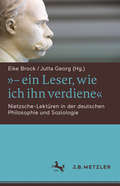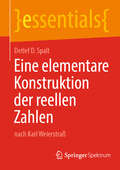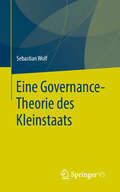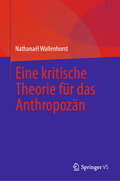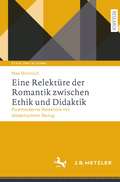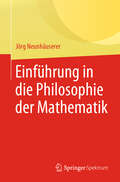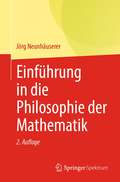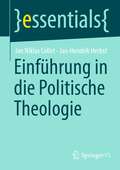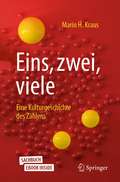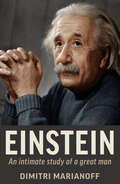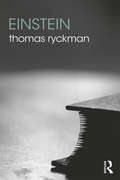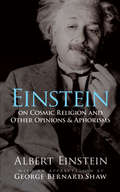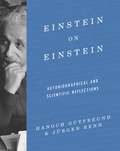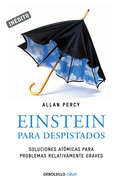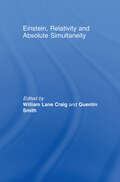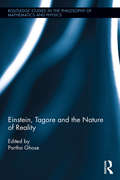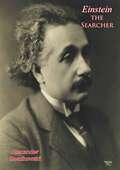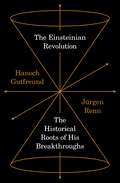- Table View
- List View
The Eight Realizations of Great Beings: Essential Buddhist Wisdom for Waking Up to Who You Are
by Brother Phap HaiA pithy guide to the Buddha's instructions to unlock the powerful insights that make us "great"—by wise, warm, and humorous Brother Phap Hai, the most senior Australian Dharma teacher ordained by Thich Nhat Hanh In this essential sutra for sincere practitioners, the Buddha says, "If you would like to be enlightened, take on these eight subjects for meditation and apply their corresponding insights to your daily life." Brother Phap Hai's lively, down-to-earth explanation of spirituality's original self-help manual makes this book a must-read for all seeking inspiration on the path of self-realization and compassion. Beginning with a brief historical overview of the sutra's origins, Brother Phap Hai explores each of the eight realizations and shares a story in each chapter from his own journey to become a monk himself.Ordaining as a Buddhist monk in 1997 while still in his twenties, Brother Phap Hai has been practicing mindfulness on a daily basis for much of his adult life. Zen Master Thich Nhat Hanh authorized him to teach in 2003, and since then, he has guided and mentored thousands of students in meditation. Brother Phap Hai calls the Buddha's Discourse on the Eight Realizations of Great Beings his "'Desert Island Sutra' because it distills the essence of the Buddhist path." In his words, it is everything you need in a practical meditation manual, "a very structured exposition of realizing the entirety of the Buddhist path for yourself."
Eight Women Philosophers: Theory, Politics, and Feminism
by Jane DuranSpanning over nine hundred years, Eight Women Philosophers is the first singly-authored work to trace the themes of standard philosophical theorizing and feminist thought across women philosophers in the Western tradition. Jane Duran has crafted a comprehensive overview of eight women philosophers--Hildegard of Bingen, Anne Conway, Mary Astell, Mary Wollstonecraft, Harriet Taylor Mill, Edith Stein, Simone Weil, and Simone de Beauvoir--that underscores the profound and continuing significance of these thinkers for contemporary scholars. Duran devotes one chapter to each philosopher and provides a sustained critical analysis of her work, utilizing aspects of Continental theory, poststructuralist theory, and literary theory. She situates each philosopher within her respective era and in relation to her intellectual contemporaries, and specifically addresses the contributions each has made to major areas such as metaphysics/epistemology, theory of value, and feminist theory. She affirms the viability and importance of recovering these women's overlooked work and provides a powerful answer to the question of why the rubric "women philosophers" remains so valuable.
Eighteenth-Century Dissent and Cambridge Platonism: Reconceiving the Philosophy of Religion (Routledge Studies in the Philosophy of Religion)
by Louise HickmanEighteenth-Century Dissent and Cambridge Platonism identifies an ethically and politically engaged philosophy of religion in eighteenth century Rational Dissent, particularly in the work of Richard Price (1723-1791), and in the radical thought of Mary Wollstonecraft. It traces their ethico-political account of reason, natural theology and human freedom back to seventeenth century Cambridge Platonism and thereby shows how popular histories of the philosophy of religion in modernity have been over-determined both by analytic philosophy of religion and by its critics. The eighteenth century has typically been portrayed as an age of reason, defined as a project of rationalism, liberalism and increasing secularisation, leading inevitably to nihilism and the collapse of modernity. Within this narrative, the Rational Dissenters have been accused of being the culmination of eighteenth-century rationalism in Britain, epitomising the philosophy of modernity. This book challenges this reading of history by highlighting the importance of teleology, deiformity, the immutability of goodness and the divinity of reason within the tradition of Rational Dissent, and it demonstrates that the philosophy and ethics of both Price and Wollstonecraft are profoundly theological. Price’s philosophy of political liberty, and Wollstonecraft’s feminism, both grounded in a Platonic conception of freedom, are perfectionist and radical rather than liberal. This has important implications for understanding the political nature of eighteenth-century philosophical theology: these thinkers represent not so much a shaking off of religion by secular rationality but a challenge to religious and political hegemony. By distinguishing Price and Wollstonecraft from other forms of rationalism including deism and Socinianism, this book takes issue with the popular division of eighteenth-century philosophy into rationalistic and empirical strands and, through considering the legacy of Cambridge Platonism, draws attention to an alternative philosophy of religion that lies between both empiricism and discursive inference.
Eihei Dogen: Mystical Realist
by Taigen Dan Leighton Hee-Jin KimEihei Dogen, the founder of the Japanese branch of the Soto Zen Buddhist school, is considered one of the world's most remarkable religious philosophers. Eihei Dogen: Mystical Realist is a comprehensive introduction to the genius of this brilliant thinker. This thirteenth-century figure has much to teach us all and the questions that drove him have always been at the heart of Buddhist practice. At the age of seven, in 1207, Dogen lost his mother, who at her death earnestly asked him to become a monastic to seek the truth of Buddhism. We are told that in the midst of profound grief, Dogen experienced the impermanence of all things as he watched the incense smoke ascending at his mother's funeral service. This left an indelible impression upon the young Dogen; later, he would emphasize time and again the intimate relationship between the desire for enlightenment and the awareness of impermanence. His way of life would not be a sentimental flight from, but a compassionate understanding of, the intolerable reality of existence. At age 13, Dogen received ordination at Mt. Hiei. And yet, a question arose: "As I study both the exoteric and the esoteric schools of Buddhism, they maintain that human beings are endowed with Dharma-nature by birth. If this is the case, why did the buddhas of all ages - undoubtedly in possession of enlightenment - find it necessary to seek enlightenment and engage in spiritual practice?" When it became clear that no one on Mt. Hiei could give a satisfactory answer to this spiritual problem, he sought elsewhere, eventually making the treacherous journey to China. This was the true beginning of a life of relentless questioning, practice, and teaching - an immensely inspiring contribution to the Buddhadharma. As you might imagine, a book as ambitious as Eihei Dogen: Mystical Realist has to be both academically rigorous and eminently readable to succeed. Professor Hee-Jim Kim's work is indeed both.
Ein grenzenloser ozean des bewusstseins
by Dr. Tony NaderEinfache antworten auf die großen fragen des lebens. Vorwort von David Lynch. «In diesem wegweisenden Buch stellt Dr. Tony Nader Ideen vor, die die Welt verändern können. Er gibt bahnbrechende Antworten auf Fragen, die seit jeher Philosophen und Wissenschaftler gleichermaßen fasziniert und beschäftigt haben. Was ist Bewusstsein? Sind wir frei? Wie können wir das Beste aus unserem Leben machen? Was können wir tun, damit sich unsere Wünsche erfüllen? Wie können wir Frieden und Harmonie unter Völkern und Nationen schaffen? Er bietet Antworten an, basierend auf einem einfachen zugrunde liegenden Paradigma, das Geist, Körper und Umgebung in einem Ozean reinen Seins, reinen Bewusstseins, vereint. Dieses Buch ist ein Muss für all diejenigen, die Antworten suchen auf Fragen nach den großen Geheimnissen des Lebens, nach der absoluten und letztgültigen Wahrheit.»David Lynch «Ich möchte, dass jeder weiß, was Bewusstsein ist und wie man es entwickelt, sodass jeder sich des vollen Potenzials des individuellen und sozialen Lebens erfreuen kann.»Dr. Tony Nader
"- ein Leser, wie ich ihn verdiene": Nietzsche-Lektüren in der deutschen Philosophie und Soziologie
by Eike Brock Jutta GeorgDieses Buch trägt die Nietzsche-Rezeption im deutschsprachigen Raum anhand der bedeutendsten Autorinnen und Autoren zusammen, wobei neben der philosophischen auch die soziologische Rezeption berücksichtigt wird. Es dokumentiert die spannenden Veränderungen des Nietzsche-Verständnisses im Wandel der Zeiten und eröffnet im selben Atemzug neue Perspektiven für die Interpretation von Nietzsches Philosophie. Nicht zuletzt ist der Band eine exklusive Informationsquelle und Orientierungshilfe für Nietzsche-Forscherinnen und -Forscher und – ganz nebenbei – eine etwas andere Geschichte der deutschen Philosophie des 20. Jahrhunderts.
Ein Österreichischer Islam für Schulen?: Rechtssoziologische Erkenntnisse zum Islam und Islamischen Religionsunterricht in Wiener Mittelschulen (Wiener Beiträge zur Islamforschung)
by Michael KramerDiese Publikation handelt von der Beziehung zwischen dem Staat und dem Islam im allgemein-politischen und im schulischen Kontext, wobei der Islam neben anderen islamischen Institutionen in erster Linie von der Islamischen Glaubensgemeinschaft in Österreich (IGGÖ) vertreten wird. Der IGGÖ – ebenso wie anderen Kirchen und Religionsgesellschaften (KuR) – werden im österreichischen Religionsrechtssystem weitreichende Autonomierechte eingeräumt, vor allem in der Schule in Form eines konfessionellen Religionsunterrichts (RU). Zur Erforschung dieser Beziehung in der Schule wird ein rechts- und politikwissenschaftlicher Blick auf die rechtlichen Rahmenbedingungen und die soziale Wirklichkeit des Islams und des RU der IGGÖ (IRU) in Wiener Mittelschulen geworfen. Konsequenterweise wird auch auf die verschiedenen involvierten Akteur*innen geblickt, insb. auf muslimische Schüler*innen und Eltern, Religionslehrer*innen, Fachinspektor*innen und sonstige Autoritäten der IGGÖ sowie Schuldirektor*innen, Bildungsdirektionen und das Bildungsministerium. Dafür wurden im Rahmen einer qualitativen Sozialforschung sieben (Schul-)Autoritäten der IGGÖ (IGGÖ-SA) als ‚Vertreter*innen des Islams‘ und sechs Wiener Mittelschuldirektor*innen (MSD) als ‚staatliche Vertreter*innen‘ interviewt. Die Interviews verfolgten drei Zwecke: 1) die Ergründung negativer rechtlicher, politischer, gesellschaftlicher und religionsgesellschaftlicher Einflussfaktoren auf die allgemeine Beziehung zwischen dem Staat und dem Islam bzw. der IGGÖ (und den Muslim*innen); 2) die Erhebung von Herausforderungen, Spannungen und Konflikten sowie Idealvorstellungen in der schulpolitischen, -bürokratischen, -organisatorischen, individuellen und korporativen Beziehungsdimension, sowie 3) die Erforschung von persönlichen Einstellungen und Haltungen von IGGÖ-SA und MSD zum Islam und dem IRU in der Schule sowie – vonseiten der IGGÖ-SA – zum Staat und der Gesellschaft. Während der dritte Zweck in dieser Publikation nur eine untergeordnete Rolle einnimmt, liegt das Hauptaugenmerk auf den abstrahierten Spannungsfeldern des 'gelebten Rechts' im Sinne der sozialen Wirklichkeit in den entsprechenden Beziehungsdimensionen, die in einer rechtssoziologischen Analyse dem normativem Recht gegenübergestellt und entlang idealtypischer Einstellungen und Haltungen auf Ursachen, Wirkungen und Lösungen untersucht werden. Die Analysethemen umfassen mitunter die Einbeziehung von Fachinspektor*innen für Religion in die Bildungsdirektionen, den Streit über die Abkürzung der IGGÖ für die Eintragung in Zeugnisse, die Schwierigkeiten in der Organisation mit dem RU, das (religiöse) Verhalten muslimischer Schüler*innen und Eltern in der Schule sowie die Grenzen der Lehre im IRU im Rahmen der staatsbürgerlichen Erziehung. Diesbezügliche Idealvorstellungen zu den Herausforderungen ermöglichen abschließend aus einer sozialintegrativen und pluralistischer Perspektive der IGGÖ-SA die Konturierung eines Österreichischen Islams bzw. eines idealtypischen IRU.
Eine elementare Konstruktion der reellen Zahlen: nach Karl Weierstraß (essentials)
by Detlef D. SpaltDieses essential stellt in kondensierter Form eine Neuinterpretation der Weierstraß'schen Konstruktion der reellen Zahlen vor: Ein vergleichsweise neuer Quellenfund lässt darauf schließen, dass der Weierstraß’sche Zahlbegriff bereits auf Mengenbegriffen basierte und somit sehr viel elementarer ist, als bislang angenommen wurde.Die beiden bislang bekanntesten Alternativdefinitionen der reellen Zahlen – mittels rationaler Folgen und Konvergenz (Cantor) bzw. als Segmente (Dedekind) – werden hier ebenfalls kurz erläutert und mit der Weierstraß’schen Konstruktion verglichen.Eine ausführliche Darstellung anhand der Originalquellen findet sich in Spalt, Die Grundlegung der Analysis durch Karl Weierstraß (Springer Spektrum, 2022).
Eine Governance-Theorie des Kleinstaats
by Sebastian WolfDieses Werk untersucht außergewöhnliche Regelungsmechanismen in Gesetzgebungsprozessen in Liechtenstein wie z. B. übergroße parlamentarische Mehrheiten, ein schwacher Koalition-Opposition-Dualismus und geringe Fraktionsgeschlossenheit. Zur Analyse wird ein theoretischer Rahmen aus Kleinstaatentheorie und Governancetheorie entwickelt und im Rahmen einer explorativen Fallstudie getestet. Das Buch trägt insbesondere zum besseren Verständnis des politischen Systems Liechtensteins und zur Weiterentwicklung der sozialwissenschaftlichen Kleinstaatentheorie bei.
Eine kritische Theorie für das Anthropozän
by Nathanaël WallenhorstDieser Band, der in biogeophysikalischen Studien verwurzelt ist, befasst sich mit Konzepten des politischen Handelns im Anthropozän und der Spannung zwischen dem Wunsch, das prometheische Projekt der Moderne zu vollenden, und einem post-prometheischen Ansatz. Diese Arbeit untersucht die Idee einer anthropologischen Mutation der politischen Konsolidierung von einem "postprometheanischen Miteinander" zur Schaffung der Fähigkeit zum gemeinsamen Handeln. Das von Hannah Arendt entwickelte politische Denken über die conditio humana ist hier als Ressource für das Denken über die Menschheit im Sinne des menschlichen Abenteuers wichtig. Dieses hat drei Dimensionen: Hybris, Welt und Koexistenz, die sich jeweils auf die Logik des Profits des homo oeconomicus, die Logik der Verantwortung des homo collectivus und die Logik der Gastfreundschaft des homo religatus beziehen.. Die in diesem Buch skizzierte intellektuelle und politische Haltung ist eine Erweiterungder kritischen Theorie: Das Werk übt auch Kritik an dem, was in unserer Beziehung zur Welt ein Problem darstellt, und schlägt vor, wie es überwunden werden kann, wobei das Endziel die soziale Transformation ist. Der Autor schlägt einen Aufstand und eine anthropologische Konsolidierung der Politik vor, die auf der Wiederbelebung beruht, die durch das Teilen einer Konvivialität sowohl zwischen den Menschen als auch mit dem Nicht-Menschlichen hervorgerufen wird. Die Identifizierung der Konvivialität als ein Bildungsparadigma, um das Anthropozän zu überleben, gibt uns trotz dieses Erbes des Anthropozäns den dringend benötigten Grund zur Hoffnung. Neben dem Arendt'schen Denken stützt sich diese kritische Theorie für das Anthropozän auf das politische Denken mehrerer zeitgenössischer Autoren, darunter Maurice Bellet, Hartmut Rosa, Andreas Weber, Dominique Bourg und Christian Arnsperger. Dieser Band ist für Forscher des Anthropozäns von Interesse.
Eine Relektüre der Romantik zwischen Ethik und Didaktik: Postmoderne Relektüre mit didaktischem Bezug (Ethik und Bildung)
by Max BrinnichAn der Schnittstelle zwischen Philosophie, Literatur, Ethik und Ästhetik liegt in derphilosophischen Fach- und Literaturdidaktik ein nicht ausgeschöpftes Potential begraben –insbesondere im Umgang mit der literarischen Romantik. Diesem Potential spürt dievorliegende Arbeit nach, indem sie Schlegels „Lucinde“, Eichendorffs „Taugenichts“ undHoffmanns „Sandmann“ einer kritischen Relektüre unterzieht, um die in der philosophischenPostmoderne viel diskutierten Übergänge zwischen Ethik und Ästhetik sichtbar zu machenund ihre Bedeutung für die Fachdidaktik zu diskutieren.
Einführung in die Philosophie der Mathematik
by Jörg NeunhäusererWelche Art von Gegenständen untersucht die Mathematik und in welchem Sinne existieren diese Gegenstände? Warum dürfen wir die Aussagen der Mathematik zu unserem Wissen zählen und wie lassen sich diese Aussagen rechtfertigen? Eine Philosophie der Mathematik versucht solche Fragen zu beantworten. In dieser Einführung stellen wir maßgebliche Positionen in der Philosophie der Mathematik vor und formulieren die Essenz dieser Positionen in möglichst einfachen Thesen. Der Leser erfährt, auf welche Philosophen eine Position zurückgeht und in welchem historischen Kontext diese entstand. Ausgehend von Grundintuitionen und wissenschaftlichen Befunden lässt sich für oder gegen eine These in der Philosophie der Mathematik argumentieren. Solche Argumente bilden den zweiten Schwerpunkt dieses Buchs. Das Buch soll den Leser dazu anregen, über die Philosophie der Mathematik nachzudenken und eine eigene Position zu formulieren und für diese zu argumentieren.
Einführung in die Philosophie der Mathematik
by Jörg NeunhäusererWelche Art von Gegenständen untersucht die Mathematik und in welchem Sinne existieren diese Gegenstände? Warum dürfen wir die Aussagen der Mathematik zu unserem Wissen zählen und wie lassen sich diese Aussagen rechtfertigen? Eine Philosophie der Mathematik versucht solche Fragen zu beantworten. In dieser Einführung stellen wir maßgebliche Positionen in der Philosophie der Mathematik vor und formulieren die Essenz dieser Positionen in möglichst einfachen Thesen. Der Leser erfährt, auf welche Philosophen eine Position zurückgeht und in welchem historischen Kontext diese entstand. Ausgehend von Grundintuitionen und wissenschaftlichen Befunden lässt sich für oder gegen eine These in der Philosophie der Mathematik argumentieren. Solche Argumente bilden den zweiten Schwerpunkt dieses Buchs. Das Buch soll den Leser dazu anregen, über die Philosophie der Mathematik nachzudenken und eine eigene Position zu formulieren und für diese zu argumentieren. Die zweite Auflage ist vollständig durchgesehen und um ein Kapitel zum Idealismus ergänzt.
Einführung in die Politische Theologie (essentials)
by Jan Niklas Collet Jan-Hendrik HerbstPolitische Theologie erlebt derzeit ein Revival: Nachdem es eine längere Zeit lang still um die Politische Theologie geworden war, erfreut sie sich – nicht zuletzt angesichts multipler Krisenerscheinungen – aktuell wieder eines wachsenden Interesses. Aber was ist „Politische Theologie“ eigentlich? Die Einführung bietet eine begriffsgeschichtliche Orientierung und systematische Einordnung dieses schillernden Begriffs, eine vertiefende Auseinandersetzung mit den Politischen Theologien des Staatsrechtlers Carl Schmitt und des katholischen Theologen Johann Baptist Metz sowie eine Reflexion ausgewählter gegenwärtiger Diskussionsbeiträge in der deutschsprachigen katholischen Theologie. Das Buch verdeutlicht die ungebrochene Aktualität und Relevanz fundierter wissenschaftlicher und öffentlicher Auseinandersetzungen mit der Politischen Theologie.
Eins, zwei, viele: Eine Kulturgeschichte des Zählens
by Mario H. KrausDieses Werk gibt einen Überblick über die Geschichte des Zählens, sowohl in mathematischen oder philosophischen als auch soziokulturellen Zusammenhängen. Die Frage "Warum und wie zählen wir eigentlich?" wird vielfältig untersucht und beantwortet. Bewusst kurz und unterhaltsam soll das Buch auch Anwendungen zeigen - im Alltag, in der Wissenschaft oder bei Volkszählungen und in der Stadtentwicklung.
Einstein: An Intimate Study of a Great Man
by Dimitri Marianoff Palma WayneEinstein: An Intimate Study of a Great Man, first published in 1944, recounts the personal life of physicist Albert Einstein (1879-1955). The book was written by Einstein’s son-in-law, who married his daughter Margot in Berlin in 1930. Einstein was a simple, direct man, but remains today larger-than-life, and as author Marianoff writes, “Einstein’s life is not an exciting one. It is not filled with the rush and sweep of spectacular adventures. It has none of the scope and danger of the explorer, who freezes and suffers and agonizes in his search. It is not filled with the stir and headiness of eventful, flamboyant episodes. It is not a colorful panorama of the human pilgrimage...It has no color at all except the color of greatness...It is a mighty epic journey of science—a steady, breathtaking march whose heroic altitude is of such heights that it precludes the ecstatic language so often applied to singular human endeavors...It has no thrill in it, except the thrill of having changed the tide of man’s history and created new channels for his growth...It has no drama in it, except the overpowering drama of a conquest so immeasurable that as long as man remains on earth he will have benefited by it.”
Einstein (The Routledge Philosophers)
by Thomas RyckmanAlbert Einstein (1879–1955) was the most influential physicist of the 20th century. Less well known is that fundamental philosophical problems, such as concept formation, the role of epistemology in developing and explaining the character of physical theories, and the debate between positivism and realism, played a central role in his thought as a whole. Thomas Ryckman shows that already at the beginning of his career - at a time when the twin pillars of classical physics, Newtonian mechanics and Maxwell’s electromagnetism were known to have but limited validity - Einstein sought to advance physical theory by positing certain physical principles as secure footholds. That philosophy produced his greatest triumph, the general theory of relativity, and his greatest failure, an unwillingness to accept quantum mechanics. This book shows that Einstein’s philosophy grew from a lifelong aspiration for a unified theoretical representation encompassing all physical phenomena. It also considers how Einstein’s theories of relativity and criticisms of quantum theory shaped the course of 20th-century philosophy of science. Including a chronology, glossary, chapter summaries, and suggestions for further reading, Einstein is an ideal introduction to this iconic figure in 20th-century science and philosophy. It is essential reading for students of philosophy of science, and is also suitable for those working in related areas such as physics, history of science, or intellectual history.
Einstein and the Quantum Revolutions (The France Chicago Collection)
by Alain AspectA Nobel laureate offers a brief lesson on physics’ biggest mystery, accessibly explaining the two quantum revolutions that changed our understanding of reality. At the start of the twentieth century, the first quantum revolution upset our vision of the world. New physics offered surprising realities, such as wave-particle duality, and led to major inventions: the transistor, the laser, and today’s computers. Less known is the second quantum revolution, arguably initiated in 1935 during a debate between giants Albert Einstein and Niels Bohr. This revolution is still unfolding. Its revolutionaries—including the author of this short accessible book, Nobel Prize–winning physicist Alain Aspect—explore the notion of entangled particles, able to interact at seemingly impossible distances. Aspect’s research has helped to show how entanglement may both upend existing technologies, like cryptography, and usher in entirely new ones, like quantum computing. Explaining this physics of the future, this work tells a story of how philosophical debates can shape new realities.
Einstein on Cosmic Religion and Other Opinions and Aphorisms
by George Bernard Shaw Albert EinsteinScience and religion are compatible, declares the famous physicist. In these essays, Einstein views science as the basis for a "cosmic" religion, embraced by scientists, theologians, and all who share a sense of wonder in the rationality and beauty of the universe. In the course of his career, Einstein wrote more than 300 scientific and 150 nonscientific publications. These essays date from the 1930s and 40s. In direct, everyday language the author develops a coherent view that transcends both the antiquated religion of fear and the modern religion of ethics. His concept of cosmic religion combines science and religion, with science forming the basis for a more enlightened religion. In these essays and aphorisms, Einstein also reflects on pacifism, disarmament, and Zionism. In addition to a brief biography of the author, this volume includes a warm appreciation by George Bernard Shaw.
Einstein on Einstein: Autobiographical and Scientific Reflections
by Jürgen Renn Hanoch GutfreundNew perspectives on the iconic physicist's scientific and philosophical formationAt the end of World War II, Albert Einstein was invited to write his intellectual autobiography for the Library of Living Philosophers. The resulting book was his uniquely personal Autobiographical Notes, a classic work in the history of science that explains the development of his ideas with unmatched warmth and clarity. Hanoch Gutfreund and Jürgen Renn introduce Einstein's scientific reflections to today's readers, tracing his intellectual formation from childhood to old age and offering a compelling portrait of the making of a philosopher-scientist.Einstein on Einstein features the full English text of Autobiographical Notes along with incisive essays that place Einstein's reflections in the context of the different stages of his scientific life. Gutfreund and Renn draw on Einstein's writings, personal correspondence, and critical writings by Einstein's contemporaries to provide new perspectives on his greatest discoveries. Also included are Einstein's responses to his critics, which shed additional light on his scientific and philosophical worldview. Gutfreund and Renn quote extensively from Einstein's initial, unpublished attempts to formulate his response, and also look at another brief autobiographical text by Einstein, written a few weeks before his death, which is published here for the first time in English.Complete with evocative drawings by artist Laurent Taudin, Einstein on Einstein illuminates the iconic physicist's journey to general relativity while situating his revolutionary ideas alongside other astonishing scientific breakthroughs of the twentieth century.
Einstein para despistados: Soluciones atómicas para problemas relativamente graves (Genios para la vida cotidiana #Volumen)
by Allan PercyEn Einstein para despistados, de la serie «Genios para la vida cotidiana», el prestigioso Allan Percy recoge 85 grandes reflexiones de este genio y las traslada a situaciones prácticas de la vida cotidiana. Sin lugar a dudas, la figura de Albert Einstein ha trascendido el ámbito de la ciencia para convertirse en un icono de la cultura moderna, comparable a las estrellas del pop o a los grandes actores de Hollywood. Y no solo por su peculiar peinado, ni por haber ganado un Premio Nobel, ni siquiera por ser el padre de la teoría de la relatividad. Además de haber revolucionado la física, Einstein fue un acérrimo defensor de la paz y un brillante pensador sobre el arte de vivir. Sus lúcidos aforismos para el día a día reflejan la sabiduría de alguien que siempre tuvo los pies en la tierra. Dentro y fuera del ámbito académico, Albert Einstein era por encima de todo un solucionador de problemas. En los tiempos que corren, en los que la presión es máxima y la compensación escasa, las enseñanzas de este físico nos ayudarán a apagar más de un fuego.
Einstein, Relativity and Absolute Simultaneity (Routledge Studies in Contemporary Philosophy)
by William Lane Craig Quentin SmithEinstein, Relativity and Absolute Simultaneity is an anthology of original essays by an international team of leading philosophers and physicists who have come together to reassess the contemporary paradigm of the relativistic concept of time. A great deal has changed since 1905 when Einstein proposed his Special Theory of Relativity, and this book offers a fresh reassessment of Special Relativity’s relativistic concept of time in terms of epistemology, metaphysics, and physics.
Einstein, Tagore and the Nature of Reality: Literary And Philosophical Reflections (Routledge Studies in the Philosophy of Mathematics and Physics)
by Partha GhoseThe nature of reality has been a long-debated issue among scientists and philosophers. In 1930, Rabindranath Tagore and Albert Einstein had a long conversation on the nature of reality. This conversation has been widely quoted and discussed by scientists, philosophers and scholars from the literary world. The important question that Tagore and Einstein discussed was whether the world is a unity dependent on humanity, or the world is a reality independent on the human factor. Einstein took the stand adopted by Western philosophers and mathematicians, namely that reality is something independent of the mind and the human factor. Tagore, on the other hand, adopted the opposite view. Nevertheless, both Einstein and Tagore claimed to be realists despite the fundamental differences between their conceptions of reality. Where does the difference lie? Can it be harmonized at some deeper level? Can Wittgenstein, for example, be a bridge between the two views? This collection of essays explores these two fundamentally different conceptions of the nature of reality from the perspectives of theories of space-time, quantum theory, general philosophy of science, cognitive science and mathematics.
Einstein the Searcher: His Work Explained From Dialogues With Einstein
by Alexander MoszkowskiThis book, originally published in 1921, is written as an introduction of the theory of relativity of Albert Einstein. Moszkowski wrote the book in a way simple to understand for everyone. He developed the content in close personal discussions and it offers a wonderful view into the human Albert Einstein and his life and work. The writer Alexander Moszkowski lived from 1851 to 1934. He was born in Pilica (Poland), lived most of his life in Germany. Moszkowski was well known with Albert Einstein and probably the first author to open Einstein's theory of relativity to a wide audience.-Print ed.
The Einsteinian Revolution: The Historical Roots of His Breakthroughs
by Hanoch Gutfreund Jürgen RennHow the Einsteinian revolution can be understood as the result of a long-term evolution of science The revolution that emerged from Albert Einstein’s work in the early twentieth century transformed our understanding of space, time, motion, gravity, matter, and radiation. Beginning with Einstein’s miracle year of 1905 and continuing through his development of the theory of general relativity, Einstein spurred a revolution that continues to reverberate in modern-day physics. In The Einsteinian Revolution, Hanoch Gutfreund and Jürgen Renn trace the century-long transformation of classical physics and argue that the revolution begun by Einstein was in fact the result of a long-term evolution. Describing the origins and context of Einstein’s innovative research, Gutfreund and Renn work to dispel the popular myth of Einstein as a lone genius who brought about a revolution in physics through the power of his own pure thought. We can only understand the birth of modern physics, they say, if we understand the long history of the evolution of knowledge.Gutfreund and Renn outline the essential structures of the knowledge system of classical physics on which Einstein drew. Examining Einstein’s discoveries from 1905 onward, they describe the process by which new concepts arose and the basis of modern physics emerged. These transformations continued, eventually resulting in the establishment of quantum physics and general relativity as the two major conceptual frameworks of modern physics—and its two unreconciled theoretical approaches. Gutfreund and Renn note that Einstein was dissatisfied with this conceptual dichotomy and began a search for a unified understanding of physics—a quest that continued for the rest of his life.
